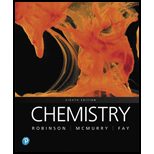
Concept explainers
Express the diameter of a nanoparticle(0.000 000 050 m) in scientific notation, and then express the number and unit with the most appropriate prefix.
Interpretation:
The diameter of the nanoparticle in scientific notation with number and unit in most appropriate prefix is to be expressed.
Concept introduction:
The size of the units on any system of measurement can be inconveniently very large or small. To solve this problem, SI units are modified by use of some appropriate prefixes that are placed before the units to signify how small or big the size of the unit is. For example, the prefix milli is used to represent one-thousandth of 1 meter.
Similarly, numbers that are too large or too small are represented by an exponential format called scientific notations for convenience.
Scientific notations are generally expressed as follows:
Where,
- n is the number of places the decimal has moved and is known as an exponent.
- m is the number.
An example is 55000 is represented as
Answer to Problem 1.1P
The scientific notation for
Explanation of Solution
Given information:
The diameter of the nanoparticle is
To assign scientific notation(
- The decimal point is moved to either right or left until a number is obtained that lies between 1 to 10.
- If the decimal is moved to the right, then the exponent is negative and if the decimal is moved to left then the exponent is positive.
- Select an appropriate prefix that is close to the exponent.
The scientific notation for
The appropriate prefix that is close to the exponent will be Nano. Nano is equal to 0.000000001 and in the scientific exponent, it will be
The scientific notation for
Want to see more full solutions like this?
Chapter 1 Solutions
CHEMISTRY-TEXT
Additional Science Textbook Solutions
The Cosmic Perspective (8th Edition)
HUMAN ANATOMY
Laboratory Experiments in Microbiology (12th Edition) (What's New in Microbiology)
SEELEY'S ANATOMY+PHYSIOLOGY
Organic Chemistry
General, Organic, and Biological Chemistry - 4th edition
- Please help me solve this reaction.arrow_forwardIndicate the products obtained by mixing 2,2-dimethylpropanal with acetaldehyde and sodium ethoxide in ethanol.arrow_forwardSynthesize 2-Ethyl-3-methyloxirane from dimethyl(propyl)sulfonium iodide using the necessary organic or inorganic reagents. Draw the structures of the compounds.arrow_forward
- Synthesize 2-Hydroxy-2-phenylacetonitrile from phenylmethanol using the necessary organic or inorganic reagents. Draw the structures of the compounds.arrow_forwardSynthesize N-Methylcyclohexylamine from cyclohexanol using the necessary organic or inorganic reagents. Draw the structures of the compounds.arrow_forwardSynthesize N-Methylcyclohexylamine from cyclohexanol using the necessary organic or inorganic reagents. Draw the structures of the compounds.arrow_forward
- If possible, please provide the formula of the compound 3,3-dimethylbut-2-enal.arrow_forwardSynthesize 1,4-dibromobenzene from acetanilide (N-phenylacetamide) using the necessary organic or inorganic reagents. Draw the structures of the compounds.arrow_forwardIndicate the products obtained by mixing (3-oxo-3-phenylpropyl)triphenylphosphonium bromide with sodium hydride.arrow_forward
- We mix N-ethyl-2-hexanamine with excess methyl iodide and followed by heating with aqueous Ag2O. Indicate the major products obtained.arrow_forwardIndicate the products obtained by mixing acetophenone with iodine and NaOH.arrow_forwardIndicate the products obtained by mixing 2-Propanone and ethyllithium and performing a subsequent acid hydrolysis.arrow_forward
 Principles of Modern ChemistryChemistryISBN:9781305079113Author:David W. Oxtoby, H. Pat Gillis, Laurie J. ButlerPublisher:Cengage LearningChemistry: Matter and ChangeChemistryISBN:9780078746376Author:Dinah Zike, Laurel Dingrando, Nicholas Hainen, Cheryl WistromPublisher:Glencoe/McGraw-Hill School Pub Co
Principles of Modern ChemistryChemistryISBN:9781305079113Author:David W. Oxtoby, H. Pat Gillis, Laurie J. ButlerPublisher:Cengage LearningChemistry: Matter and ChangeChemistryISBN:9780078746376Author:Dinah Zike, Laurel Dingrando, Nicholas Hainen, Cheryl WistromPublisher:Glencoe/McGraw-Hill School Pub Co Chemistry: Principles and ReactionsChemistryISBN:9781305079373Author:William L. Masterton, Cecile N. HurleyPublisher:Cengage Learning
Chemistry: Principles and ReactionsChemistryISBN:9781305079373Author:William L. Masterton, Cecile N. HurleyPublisher:Cengage Learning Chemistry & Chemical ReactivityChemistryISBN:9781337399074Author:John C. Kotz, Paul M. Treichel, John Townsend, David TreichelPublisher:Cengage Learning
Chemistry & Chemical ReactivityChemistryISBN:9781337399074Author:John C. Kotz, Paul M. Treichel, John Townsend, David TreichelPublisher:Cengage Learning Chemistry: The Molecular ScienceChemistryISBN:9781285199047Author:John W. Moore, Conrad L. StanitskiPublisher:Cengage Learning
Chemistry: The Molecular ScienceChemistryISBN:9781285199047Author:John W. Moore, Conrad L. StanitskiPublisher:Cengage Learning





